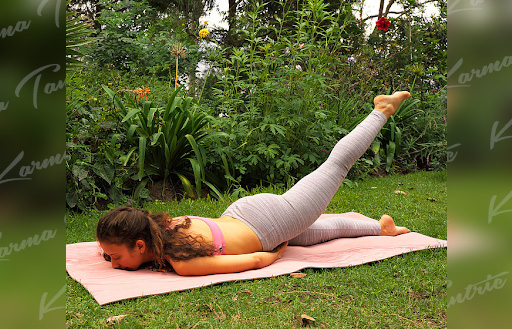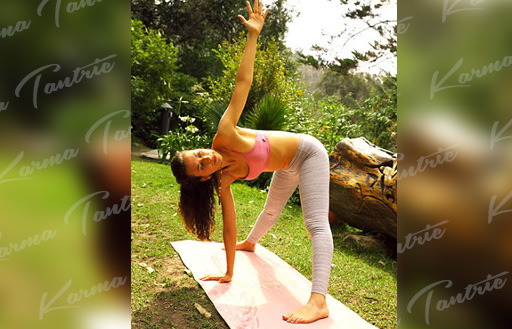Tantra Yoga: What is it? How to practise it? Poses & techniques
While many associate tantra with sex or massage, tantra was originally a yoga practice. You may have heard about kundalini yoga but what about traditional tantra yoga? It is a practice over 7000 years old, deriving from the Vedas and making it one of the oldest forms of yoga. It increases strength, flexibility, precision and health and is a good way to explore our body. In this guide to tantra yoga, you will learn exactly what is tantra yoga, how it’s different from other types of yoga and how to practise it including some positions and techniques. I hope you enjoy it!
What is tantric yoga?
So what is Tantra Yoga? The definition is as follows:
“Traditional Tantra Yoga is a deeply meditative practice combining standing Hatha positions and floor-based Yin positions”
It is designed to support the tantric cosmo-vision and is a restorative yoga practice with long phases of relaxation and meditation. It allows for an easier connection with yourself and your intimate partner(s). When we practice traditional tantra yoga, we become aware of the power of energy within us. We realize that our body is not as rigid and firm as we perceive it. We learn that we can move our body without effort, simply and with intention.
What are the main goals of tantra yoga?
In Sanskrit, tantra means “network”. It refers to weaving together patches of fabric into a larger whole. This image illustrates the Eastern belief that everything is interconnected and in communication. Nothing exists independently, and everything is part of the same reality.
In Sanskrit, yoga means to “union”.
So we can define Tantra Yoga as the union of several networks in existence. Tantra and yoga together help us unite and connect with ourselves and others. Tantra yoga helps us experiencing this interconnection. We bring the unconscious conscious and polarities within us into balance.
How is tantra yoga different from other forms of yoga?
- Tantra Yoga has long phases of deep relaxation. In true relaxation, the mind shuts off, allowing for an easier connection to yourself. New information is stored and transmitted at a cellular level through repetitions. From that space, you become more free, more loving, more connected.
- The goal is not to gain a more flexible body for aesthetic reasons. The goal is to become more flexible by releasing emotional tightness and blocks.
- Poses are reached by surrendering practices, unlike Hatha, Vinyasa or Iyengar Yoga. If you cannot reach a posture, visualize yourself in it but don’t push your body. Where you feel tension, connect to it by breathing into this place. Create more space. Breathe out while letting go of all tension.
- There is no way of doing it right or wrong. The practice brings you into your own body so that you can feel what works for you in the moment. There is no reason for the teacher to correct your posture. Your body has the freedom of doing the postures in an intuitive way and through relaxation.
- Tantra celebrates our body as our temple. While other traditions see the body as an obstacle, Tantra uses it as a tool for transformation. It recognizes it is not the body that is the problem, but our relationship to our body.
- There is no way to reason to cover the silence with music as the silence is perfect. You learn to be comfortable with the silence, which helps when with an intimate partner.
- Traditional Tantra Yoga is slow and mindful. It lasts for about 2.5 to 3 hours per session. When done regularly, it improves your other yoga practices and your life in general.
Does tantra yoga involve sex?
Tantra Yoga can improve your sex life by helping you be present in your own body. You empty your mind from thoughts that prevent from connecting with yourself and your partner. Besides, each position is designed to move the flow of sexual energy – the kundalini energy- to your crown chakra, your head.
When you practice Tantra Yoga with a partner, it leads to a deep and intimate connection with one another. Through breath, eye contact, touch and movements, partners are more open to trusting themselves and others.
Benefits of practising tantra yoga
-
- Relaxation – Tantra Yoga is relaxing in nature, as deep breathing helps you relax allowing your cells to process new information gained during the active postures
- Connection – It supports connecting with and feeling every sensation in your body. If you have any tension in your body, you learn to identify where and how to release the tension.
- Patience – It helps you build up patience and resilience. It helps to find comfort in discomfort and letting go of the suffering.
- Integration – It integrates mind, body and spirit, as an experience of divinity. It awakens your feminine and masculine energies and brings balance between both.
- Meditation – When we practice Tantra Yoga, we also practice meditation as we move into the series with eyes closed and in silence.
How to practice tantra yoga
You must wonder how to do tantra yoga and if anybody can practice it? The answer is: YES. Anybody can practice Tantra Yoga, even if you are a complete beginner in Yoga or Tantra. A session of Traditional Tantra Yoga has three parts called “series”. It helps to balance your chakras and to elevate your mood.
Here is a brief introduction on how to practice tantra yoga:
-
-
-
Series 1: Warm-Up
The warm-up is done while standing or sitting. The goal is to create heat in the body and loosen the spine. It helps you being grounded and opening your first and second chakra. This series lasts for about 45 minutes.
-
Series 2: Tri-Dosha Shava Asana
It is completed on the back. With each position, you become aware of the tension, blocks, and stored emotion in the body. This is a space for release and helps you open your second, third and fourth chakra. The active postures are interspersed with passive postures, allowing you to relax. This series lasts for about 90 minutes.
-
Series 3: Makra Asana
It is completed on the belly, interspersed with Makra Asanas, the crocodile pose. Whilst in crocodile, the goal is to stay alert and relaxed at the same time. By breathing into your lower back, you expand and spread “life force energy”(prana) through the body. It opens the fourth, fifth, sixth and seventh chakra. This series lasts for about 30 minutes.
-
-
Tantra yoga positions and techniques
In Traditional Tantra Yoga, the positions are always the same, repeated in the same order. Here is a few selection of the asanas (tantra yoga positions) that you can easily try at home:
-
-
-
Salabha Asana: Locust Position
- Make a fist with each hand and place both hands under your hips.
- Chin is on the mat.
- Exhale and lift your right leg, engaging your abs and your leg, pointing your toe.
- Try to lift a little bit higher.
- Repeat on the right side.

-
Upa Trikona Asana: Standing Triangle
- Open your legs hips wight apart.
- Exhale and bend forward, bringing your left/right hand in line with your feet on the mat.
- Inhale and stretch your opposite arm towards the sky, same line of your shoulders.
- Look at the hand facing the sky.
- Repeat on the other side.

-
Shava Asana: Corpse
- Relax on your back.
- On your mat, open your legs wide enough so that your hips can relax. Open your arms wide enough, palms facing the sky, so that your chest and shoulders can relax.
- Allow yourself to completely relax.
- Disengage yourself from your environment and be in your own sacred space.
- Take a big breath in and hold your breath for 28-30 seconds two times. The first breath into stomach, and the second breath into your ribs cage.
- Your body is floppy, flexible, and relaxed.
- This asana seems the easiest to perform but it is the most difficult to master. The challenge is to maintain awareness without effort or exertion. A deep state of silent consciousness is different from sleep, which is a common experience in this pose.

-
Garbha Asana: Foetus Position
- Back on your mat, bring your ankles together. Cross them above your head, making a hole with your feet.
- Climb through the hole with your hands.
- Breathe deeply.
- In this position, be careful not to over-stretch the back of the neck. Avoid overflowing the cervical spine if there isn’t enough mobility in the rest of the spine.
- It is a challenging position but the best position to feel your perineum and reconnect with this part of your body.

-
Macra Asana: Crocodile Position
- Belly and forehead on the floor, bring your hands and feet together.
- Your arms are straight above your head, in prayer mode (pranama mudra).
- Heels and big toes touch each other. If it is uncomfortable, feel free to allow the heels to separate.
- Release your front body into the ground and fill your back body with breath and light. Visualize a silver light (cool and feminine) or a gold light (warm and masculine).
- Stay relaxed, yet alert, like the crocodile while feeling the massage your third eye.

-
Did you know? – Tantra Yoga helps us opening of all our 7 Chakras at once. When opened, we experience a sense of liberation, harmony and contentment.Consider Learning More About Tantra
Tantra reconnects us with our body and increases our vitality. It teaches us how to investigate a certain spaciousness within your body and is a wonderful thing to combine with tantra yoga. If you are curious to learn more about tantra read about the history of tantra here where our Editor, Erica, uncovers the magical world of tantra. Here at Karma Tantric we also offer a rage of tantric massage services for men, women and couples. To find out more, read: Choosing The Right Karma Tantric Massage Experience For You to help you understand the different Karma Tantric massages available.
More Tantra Articles
-


































 KARMA TWEETS
KARMA TWEETS
WHAT’S BEING SAID
Lovely Yasmin, it is great to hear from you. I hope to...
It is lovely to read a personal message and to know you...
It is so wonderful to hear all your lovely comments and messages...
This is excellent, thank you! It is nice to see the red...
Hello there Jay. I completely understand the difficulty in navigating the different...